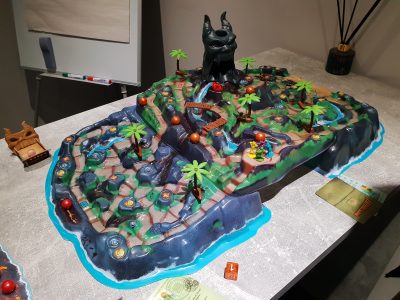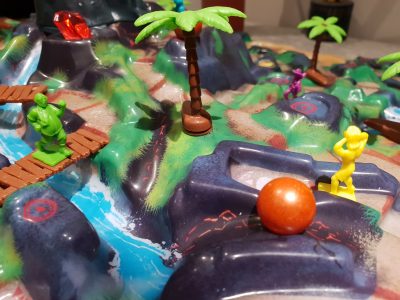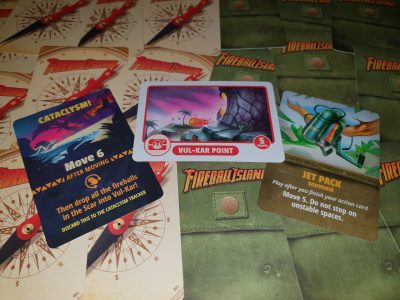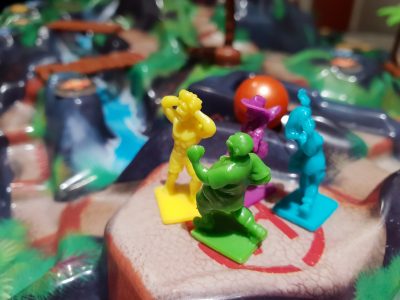Fireball Island The Curse of Vul-Kar was kickstarted earlier this year, raising a whooping $2.8 million, and it has now reached retail. Coming from Restoration Games, with designers including Rob Daviau, JR Honeycutt and Justin D. Jacobson chipping in, the game is a reimplementation of the 1986 title Fireball Island. With press your luck vibes the game sees 2 – 4 players move around the island collecting treasures. Though, with fireballs raining down it may not be a simple task! Let’s find out if it is a task worth undertaking.
On paper setup should take a while, after putting the three game board elements together. There are bridges, Vul-Kar’s head, a ladder, palm trees, ember marbles and over 35 treasures to place onto designated spots. It sounds a lot but even with only two players it can be done in around a minute or two. A side cataclysm board is added with three fireballs placed on it with a fourth added to the island scar. Each player then takes a coloured character card and places their respective character pawn into the Hello-Copter (the helicopter). Everyone gains two action cards and a souvenir card, and the game is ready to start – with the youngest player kicking the game off, leaving from the Hello-Copter onto the helipad.
Each players’ turn consists on 4 stages. Firstly, if your character has fallen over for whatever reason they must be stood back up at the start of your turn. If the character is on one space they simply stand there; if they cover two spaces the player gets a choice; if they are in something like a river they follow the flow to the bottom space and if they are off the board they start approximately where they exited from. Once back up on your feet it is time to play an action card.
Action cards feature a mandatory movement value and often an optional bonus action. Players must move the full movement indicated on the card unless the step onto a bridge, go up a ladder or enter a cave they can’t leave – where movement is instantly ended. When moving players move along the light spaces, travelling over darker mud patches that split spaces and hopping over both other players and palm tree roots.
If a character passes or starts their turn next to a treasure point the player can take one, if any are left at that location. Walking past a snapshot will allow you to take a quick picture, in-game, awarding a snapshot card of the respective location if cards are available. Caves are the only aspect where a dice comes into play, unlike the original. When entering a cave the player rolls the dice to see which entrance they must leave from. After movement the actions could be to rotate Vul-Kar himself by one step or repoint a palm tree, flick an ember or even rain destruction down via a cataclysm event. There are six ember marbles that can be flicked with a single finger. Knocking another player down allows you to steal a treasure from them but if the ember marble leaves the island any hits are voided and you must discard a treasure to the Maw.
For a cataclysm card scoop up all the fireball marbles in the scar and one by one drop them into the top of Vul-Kar’s head, seeing them roll and bounce down the island – potentially sending characters tumbling. After this instead of being merely discarded the cataclysm card is placed next to the tracker. When 3 cataclysm cards are here an additional Fireball is added from the tracker board to the scar On top of this, three cataclysm cards are shuffled back into the deck – making things more deadly. Fireballs, like with embers, see hit players will lose a treasure. Thankfully, as a catch up mechanic, if you are a victim of either marble you gain a souvenir card. These can be played on your turn giving a variety of benefits from a jet pack which offers unstopped movement to a park map to let you choose a specific cave exit.
The active player now draws a new action card and it is almost onto the next player. Only at the end of a turn is the board reset, with bridges, the ladder and marbles replaced. Note that, character pieces stay knocked down until it is their owners turn. Play continues around the table until either one player has 3 different snapshot colours or the scar is full – having four fireballs. At this point the Hello-Copter returns to help players escape, with players having two rounds to “get to the chopper”!
Upon entering the Hello-Copter players become immune from being hit or stolen from, and also get to pick a treasure from the Maw. Once the game is over points are awarded for sets of coloured treasures, if a player is on the Hello-Copter they are awarded 5 points for snapshots and if anyone managed to make it off the island with the heart of Vul-Kar or the Lucky Penny (from the Maw) bonus points are granted. The winner is the player with the most points, with ties split by whomever boarded the Hello-Copter first or is closest to it at the end of the game.
Turns and actions are kept simple and this helps the game flow from one turn to the next with only minor thinking despite choices being on offer. Players are effectively getting back up and charging onward, no matter what has occured, via simply playing a card – making the game as easy to teach as it is to play. The punishment of being knocked down and spoiling a plan is countered by gaining a bonus souvenir card, helping the family friendly feel of the game. Even targeted players aren’t instantly resigned to losing – after being peppered with fireballs or embers.
Despite a fair few things being reset from one round to the next, with everyone diving in to help, this surprisingly doesn’t produce a experience draining amount of downtime. I went into the game worried this could be a long term frustration point but it is strangely a point of entertainment, seeing quite how much destruction a single marble, or a cluster, has caused.
As with many titles originally funded via Kickstarter the production quality of most of the components is high. While incredibly light the three plastic island pieces are strong and sturdy, perfect for when players inevitably rest on them to flick the ember marbles. The gloss on the plastic isn’t to my taste, I would have prefered gloss on the rivers of water and lava but matt for the pathways and island areas, conversely others are in awe of it. The sheer size of the board dominates most games giving it real table presence topped off by Vul-Kar himself.
Only a couple of elements let the game down. While they need to be small to not clutter the island the treasure tokens are on the fiddly side. The box itself is also less that to be desired. It is notably made of thin cardboard and the lack of any kind of insert or dividers makes buying extra baggies a necessity for the components not to rattle around the box. To make matters worse once unboxed getting everything to fit back perfectly to close the lid seems an impossible task.
Overall, Fireball Island The Curse of Vul-Kar is a fun family weight board game and it is extremely easy to get new players excited to play – thanks to the look of the box and the board when it is setup. Once the game is at the table it is a breeze to teach, with turns effectively being play a card, follow what it says – perhaps followed by some chaos and laughs. Restoration Games might not have another table staple on their hands as much as Downforce. Nevertheless, for the childlike fun that flicking marbles creates this will surely tick many boxes for gamers – whether they played the original and have that emotional connection or like me are new to running from fireballs!
[Editor’s Note: Fireball Island The Curse of Vul-Kar was provided to us by Restoration Games for the review. Check out the Restoration Games’ website for details on how to purchase the game or visit your friendly local games store.]





